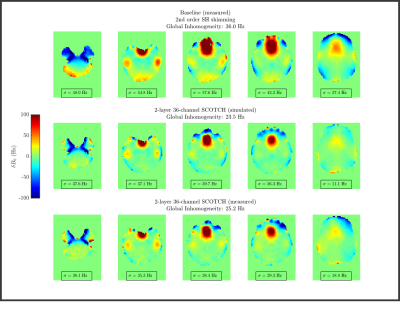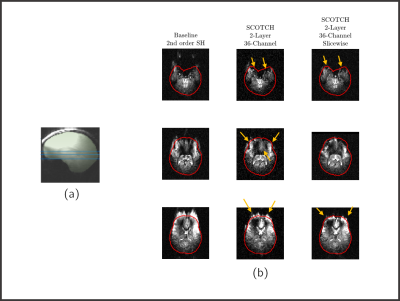3107
Shim Coils Tailored for Correction of B0 Inhomogeneity in the Human Brain (SCOTCH) at Ultra High Field1Université Paris-Saclay, CEA, CNRS, BAOBAB, NeuroSpin, Gif-sur-Yvette, France, 2Athinoula A. Martinos Center for Biomedical Imaging, Charlestown, MA, United States, 3Harvard Medical School, Boston, MA, United States, 4Université Paris-Saclay, CEA, Institut de Recherche sur les Lois Fondamentales de l'Univers, Gif-sur-Yvette, France
Synopsis
A Singular Value Decomposition based Multi-Coil Array for B0 shimming of the human brain was designed from a database of 100 δB0 fieldmaps. An optimized 2-layer 36-channel MCA design was obtained and constructed. The system was characterized and measured fieldmaps were used for comparison to expected performance from ideal simulated fields. The static whole-brain and dynamic slice-wise shimming was validated in-vivo and assessed with GRE and EPI acquisitions at 7 Tesla.
Introduction
Susceptibility-induced static-field inhomogeneity in the human brain becomes stronger with the main B0 field. As MRI scanners move to Ultra-High Fields (UHF) of 7T, 10.5T, 11.7T1 and higher, 2nd/3rd order Spherical Harmonic (SH) shim systems commonly available in commercial scanner are insufficient to provide artifact-less high-resolution acquisitions, especially in Echo Planar Imaging (EPI).To push the boundaries of B0 shimming at UHF, we have proposed a new method for Multi-Coil Array2-4 optimization based on Singular Value Decomposition (SVD) of Stream Functions (SF)5-7. Optimized channel geometry and placement over a cylindrical surface are obtained, delivering higher performance than conventional matrix MCAs (M-MCAs) with reduced channel count.
A 13-channel prototype was recently presented7 and expected system performance was assessed from measured fields, providing satisfying match to estimations from ideal, simulated fields. In this work, we present an improved optimized MCA prototype, denominated SCOTCH, consisting on 2 layers and 36 channels. The prototype was characterized, shimming simulations using measured fields were performed on two different fieldmap databases for cross validation, and finally, in-vivo acquisition was performed for quantitative and qualitative assessment.
Materials and Methods
An in-house 100-subject $$$\delta{}B_0$$$ brain fieldmap database7, scaled to 7T, was employed for the SVD-based MCA design, optimized for global (whole-brain) shimming. Cylinders of 140.5-mm and 149.0-mm radii, and 300-mm length, were used as coil formers in the optimization, centered at the MRI isocenter. A 2-layer 36-channel design is obtained (Fig. 1a). Expected inhomogeneity mitigation of the designed system was simulated on the in-house database and on an open-access database8 for cross-validation. Coils are assumed to have 20 turns.For construction of the prototype, 3D printed molds were used to wind each coil to 20 turns. These are placed onto the corresponding fiberglass cylindrical surface (Fig. 1b) and coated with epoxy resin. An open-source multi-channel current driver9 is used for electric current control of individual channels.
System characterization was performed with fieldmap measurement of each channel/coil at 1A in a large oil phantom. After characterization, expected shimming performance was assessed by inputting the measured fields per unit current as shimming basis for computational global shimming of both design and cross-validation database.
Two M-MCAs of 24 and 48 twenty-turn circular loop channels over cylindrical formers of identical dimensions to SCOTCH’s first layer are also simulated for comparison (Fig. 1c).
Finally, an in-vivo acquisition with SCOTCH shimming was performed in a 7T Siemens MAGNETOM using a simplified single-loop Tx/Rx RF setup (Fig. 2), as the in-house 8Tx/32Rx RF coil to be used with SCOTCH is still in fabrication. To accelerate Internal Review Board authorization for the experiment, Restricted SAR10 (rS) sequences were employed. A triple-echo 3D rS-GRE was used for field mapping and brain masking, required for optimal channel current calculation; and a 2D rS-EPI was employed for qualitative assessment of artifact mitigation. EPIs under global (static) and slice-wise (dynamic) shimming were acquired, with optimal currents for the 36 channels computed from a 2nd-order SH-shimmed baseline fieldmap (obtained after brain masking and re-shimming). Due to the simplified RF setup, no acceleration was possible in the EPI acquisitions, rendering it very sensitive to B0 field inhomogeneity.
Current amplitude is constrained to 3A per channel in all shimming simulations and in-vivo experiment.
Results and Discussion
Simulations with SCOTCH’s ideal and measured fields over both databases show good agreement between performances (Fig. 3). A small drop is seen for the prototype, with slightly higher average final inhomogeneity on both in-house and open-access databases (44.5 Hz to 45.9 Hz, and 38.3 Hz to 39.6 Hz, respectively, with 36 channels). This drop is not surprising, as realistic wire bundles deviate in geometry relatively to ideal single-loop models used in preliminary simulations. Compared to SH, SCOTCH’s performance is expected to be within that achieved by 5th and 6th order SH systems. Compared to M-MCAs, 24-channel SCOTCH shows vastly superior performance than a 24-channel M-MCA, while 36-channel SCOTCH is expected to provide slightly superior performance to that of 48-channel M-MCA.Fieldmaps from in-vivo acquisition are shown in Fig. 4. Significant inhomogeneity reduction is obtained in the frontal lobe (3rd and 4th columns). Ameliorations in the temporal lobes and right above the ear canals, regions notoriously hard to shim, are also observed. Measured global inhomogeneity (25.3 Hz) is close to expectations (23.5 Hz), despite deviations on upper slices (4th and 5th columns), which might be caused by differences in SCOTCH positioning relatively to characterization setup.
Fieldmap results are corroborated by EPI acquisitions (Fig. 5), where geometric distortion is greatly reduced in the frontal lobe, with marked signal recovery as well. Although optimized for global shimming, SCOTCH can provide further improvement when in slice-wise shimming, with ameliorations on the first and last slices. Yet, some degradation is seen in the middle slice compared to global shimming, again, possibly caused by imperfect positioning of the shim system relative to characterization.
Conclusion
SCOTCH simulations from ideal and measured fields over different databases showed adequate agreement in performance, providing confidence in the design, which outperforms more conventional matrix arrays. In-vivo acquisitions confirmed the system efficiency in artifact mitigation. Improvements are still expected after better characterization and more accurate positioning of the system for future experiments with the 8Tx/32Rx RF coil.Acknowledgements
This work received financial support from the Leducq Foundation (large equipment ERPT program, NEUROVASC7T project)References
1. L. Quettier et al. Commissioning Completion of the Iseult Whole Body 11.7 T MRI System. IEEE Trans. on Applied Supercondutivity 2020; 30(4):1-5.
2. C. Juchem et al. Dynamic multi-coil shimming of the human brain at 7T. Journal of Magnetic Resonance 2011; 212(2):280–288.
3. J. P. Stockmann et al. A 32-channel combined RF and B0 shim array for 3T brain imaging. Magn. Reson. Med. 2016; 75(1):441–451.
4. A. Aghaeifar et al. Dynamic B0 shimming of the human brain at 9.4 T with a 16-channel multi-coil shim setup. Magn. Reson. Med. 2018; 80(4):1714–1725.
5. B. Pinho Meneses, M. Luong, and A. Amadon. Optimized multi-coil array design for human brain shimming at Ultra-High Field. Proc. ISMRM 2019; p.1477.
6. B. Pinho Meneses and A. Amadon. Static-magnetic-field shimming coil system for magnetic resonance imaging. European Patent 072081EP/EPR 2019.
7. B. Pinho-Meneses et al. First prototype of a Stream-Function-based Multi-Coil Array dedicated to human brain shimming at Ultra-High-Field. Proc. ISMRM 2020; p.766.
8. H. Elshatlaway et al. An open dataset of 126 human brain field maps. Proc. ISMRM 2020; p. 4219.
9. N. Arango et al. Open-source, low-cost, flexible, current feedback-controlled driver circuit for local shim coils and other applications. Proc. ISMRM 2016; p.1157.
10. A. Vignaud et al. Fast and unconditionally
safe in vivo MR head protocol for home-made coil prototype assessment at 7T.
Proc. ESMRMB 2019.
Figures




